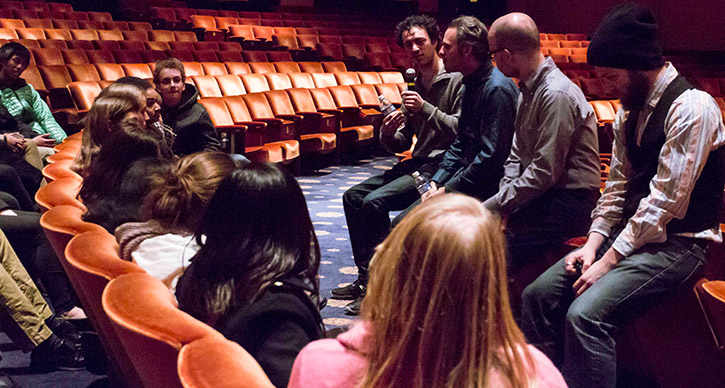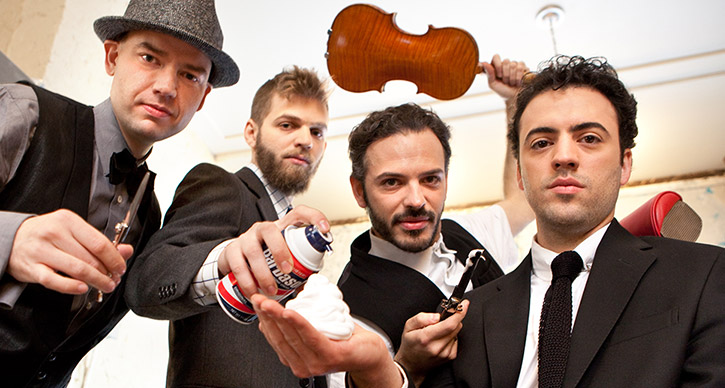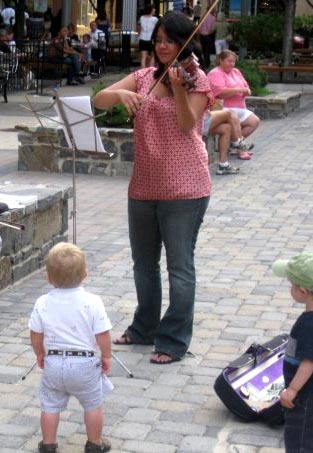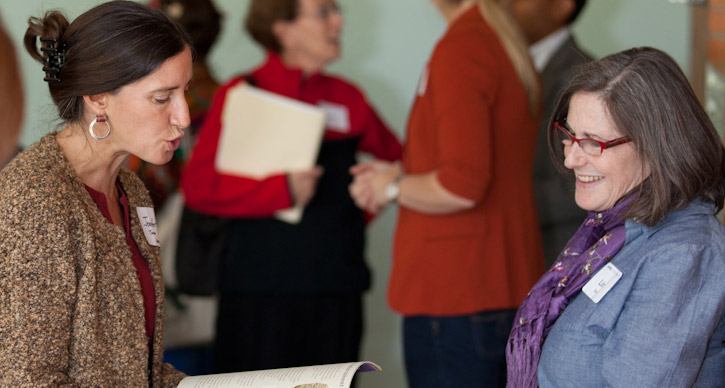UMS TalkOut Project: Brooklyn Rider
Editor’s note: This post is a part of a series. View all TalkOut events.

Photo: Q&A with Brooklyn Rider after UMS School Day performance. Photo by Jesse Meria.
Our TalkOut project for K-12 students involves speaking and listening (two core K-12 learning competencies) and creating a sharing ripple that allows the experience of a UMS School Day Performance to live on in the minds and hearts of young people and that helps students make connections between the arts on stage and their classroom.
This “TRIMTAB” pilot project was developed with guidance from Eric Booth at the Kennedy Center Partners in Education Program’s February 2013 Annual Meeting by the Michigan 1997 Team: Ann Arbor Public Schools (Robin Bailey), UMS (Jim Leija and Omari Rush), and the Washtenaw Intermediate School District (Jennifer Scott-Burton).
TalkOut encompasses the entire UMS School Day Performance experience. Prior to the start of the show an onstage host provides the entire audience with a framing question. At the end of the performance, two students (selected by UMS and school teachers pre-performance) are invited on stage to share their thoughts and ideas with the entire audience. The feedback is immediately celebrated, captured with photos and audio, and passed on to others for shared reflection.
Listen to two students reflect on their experiences at November 2013 Brooklyn Rider performance:
Interested in learning more? Download the TalkOut Project Description
Our interview with members of Brooklyn Rider
Brooklyn Rider’s Johnny Gandelsman, Nicholas Chords, Colin Jacobsen, and Eric Jacobsen talk visiting Ann Arbor and explain why they’re excited about working with banjo star Béla Fleck.
They perform at Rackham Auditorium on November 24, 2013.
UMS Playlist: Bluegrass by UMS Associate Programming Manager Liz Stover
This post is a part of a series of playlists curated by UMS staff, artists, and community. Check out more music here.

Photo: Brooklyn Rider (performing in Ann Arbor on November 24, 2013). Photo by Sarah Small.
Having grown up in a household where jam bands were in frequent rotation on our stereo, and having developed a musical background in violin, that I eventually loved bluegrass music is no big surprise. Bluegrass is a genre of frequent collaboration — many of the artists in this playlist play in bands together or work on projects with each other while also maintaining their own solo projects or groups.
I fell in love with the music of Punch Brothers when UMS presented them in October 2009 at the Power Center, and have since followed their musical endeavors and discovered other exciting artists along the way. Here in Ann Arbor, we’re also lucky to have the Ark, a stellar local institution that is a national leader in the presentation of folk and bluegrass music.
This season, I can’t wait to welcome back Chris Thile (the mandolin player of the Punch Brothers) in October for a solo performance to follow his forthcoming record release of Bach sonatas and partitas. I am also really excited that we’re bringing banjo player Béla Fleck back with the exciting young string quartet Brooklyn Rider (who are also members of the Silk Road Ensemble) in November, mixing two of my favorite genres, bluegrass and chamber music! If this playlist and those two shows leave you wanting more, check out vocalist Sarah Jarosz or An Evening with Noam Pikelny (banjo), Bryan Sutton (guitar), Jesse Cobb (mandolin), Barry Bales (bass), and Luke Bulla (fiddle), both at the Ark in October.
What did you think about this playlist? Share your thoughts or song suggestions in the comments below.
Educator Conversations: Brooklyn Rider
Editor’s note: This post is a part of a series of conversations between educators in the K-12 community. Educators will offer suggestions and answer questions about integrating UMS School Day Performances or the arts into classroom curriculum, as well as share advice on organizing a field trip to UMS. To volunteer to be a Teacher Lobby Moderator e-mail umsyouth@umich.edu. See other Educator Conversations here.
This week’s questions:
- What does “Brooklyn Rider” mean?
- How does a group like Brooklyn Rider learn to play different genres of music convincingly?
- What are some tips for listening to string quartet music?
This week’s moderator: Emily Barkakati is an Ann Arbor-based violinist, community educator, and teaching artist.
 Emily is an Ann Arbor-based violinist, community educator, and teaching artist. She plays with the Michigan Opera Theatre and the Ann Arbor Symphony, organizes events for the Medical Arts Program, runs workshops, and teaches kids how to coordinate their finger hands with their bow arms. She loves crafting, cooking, and learning, and spends a lot of time with her husband and their emotionally dysfunctional cat.
Emily is an Ann Arbor-based violinist, community educator, and teaching artist. She plays with the Michigan Opera Theatre and the Ann Arbor Symphony, organizes events for the Medical Arts Program, runs workshops, and teaches kids how to coordinate their finger hands with their bow arms. She loves crafting, cooking, and learning, and spends a lot of time with her husband and their emotionally dysfunctional cat.
Q: What does “Brooklyn Rider” mean?
Brooklyn Rider’s name is a combination of inspiration from Der Blau Reiter (The Blue Rider) and the borough of Brooklyn in New York City. Der Blau Reiter was a pre WWI Munich-based artistic collective with members such as artist Vassily Kandinsky and composer Arnold Schoenberg. Brooklyn is the place the quartet considers home. The name “Brooklyn Rider” is meant to represent the collaborative spirit of eclectic art-making, both similar to what was found in Der Blau Reiter and in the rich cultural array found in Brooklyn, New York.
Whether it’s the title of a book, work of art, piece of music, or even historical event, there is often a lot that can be derived from something’s name. One of the many ways that students can explore this idea is through the analysis of their own names. For instance:
- What is the etymology of your first name? What about your last name?
- Were you named after anyone?
- Is there a cultural significance to your name? For instance, my last name “Barkakati” comes from my Assamese heritage, and I’ve been told by older relatives that based on traditional Indian naming conventions, our family would have historically been writers.
- Is there a nickname you prefer to go by? What do you think makes it a better representation of your personality?
- What if you could change your name? What would you pick and why?
Students can then use these questions to explore and gain ownership over their personal identities. This kind of exercise could also be expanded into an artistic activity, such as creating a work of art to represent one’s name.
Q: How does a group like Brooklyn Rider learn to play different genres of music convincingly?
Although I can’t speak for Brooklyn Rider, in my own experience I am a predominantly classically trained musician who only started dabbling with improvisation and cross-genre work only in the past few years. The first step I took in my preparation was to simply listen to a lot of music. This is a similar process to learning to write in different styles. Reading a wide variety of genres and authors expands your vocabulary and stylistic knowledge. In the same way, listening to a wide variety of music expands your aural vocabulary. That way when you start playing, you might not know the technical adjustments to achieve the correct sound, but you at least have a mental sound to strive toward.
For me, the most difficult part of jumping into new genres of music was getting over the fear of making mistakes. When I began learning to improvise, a friend of mine gave me the following tips to help me get comfortable:
- Pick a song that you know well.
- Play along with a recording of the song by ear.
- Play along with the recording again, but this time start adding some embellishments.
- Write down some new melodies that would fit into the song. Try playing them on top of the recording.
- Start making up some new melodies on the spot when playing with the recording.
- Remember that there is no such thing as a wrong note! If you play a note that sounds wrong, just turn it into a grace note or an embellishment.
It was important for me to build from my preexisting knowledge in order to gain confidence in my abilities. It also helped tremendously that I had friends who created a safe environment for me to experiment and to receive constructive feedback. The same process of building knowledge in stages, also known as scaffolding, is useful for learning any new genre.
Q: What are some tips for listening to string quartet music?
The key to listening to unfamiliar string quartet music, or any type of complex music, is active listening (as opposed to passive listening). One of the joys of complex music is that there are so many layers – you can listen to a piece many times in many different ways, and always find new exciting elements. At the same time, these many layers are exactly what can also make complex music seem overwhelming. Although different people have different approaches, the key for me is to remain open-minded and allow myself to react in the moment to what is happening. Below are some of the things I think about when listening to unfamiliar music for the first time.
- What are some adjectives that come to mind on my first hearing of the piece?
- Are there any particular melodies that stick out to me? Did I hear them more than once?
- Did the piece remind me of anything that I’ve heard before? Did it invoke any memories or mental images?
- What did I like the most about the piece?
- Is there anything about the piece that I found confusing? What about it was confusing? What are some ways that I can try approaching that section differently to better understand it?
While some believe that it is necessary to research new music in advance in order to understand it, I do not think that this is always the case. I usually prefer to explore my impressions first and then research after. This way my reactions to the piece aren’t influenced by pre-existing interpretations. However, keep in mind that this is just one of many ways to explore new music.
What do you think? Share your responses or questions in the comments section below.
New! Educator Conversations

Photo: Emerson School educator Jennifer Tanau and UMS Advisory Committee member Linda Spector at a UMS reception for teachers. Photo by Mark Gjukich Photography.
This season, look for Educator Conversations on UMS Lobby.
Educators will offer suggestions and answer questions about integrating UMS School Day Performances or the arts into classroom curriculum, as well as share advice on organizing a field trip to UMS. To volunteer to be a Teacher Lobby Moderator e-mail umsyouth@umich.edu.
Educator Conversations will take place around UMS School Day Performances. As soon as the conversations are live, we’ll include a link on this page.
- Hubbard Street Dance Chicago with Melissa Poli (Performance September 27)
- Ukulele Orchestra of Great Britain with Katie Ryan (Performance November 12)
- Brooklyn Rider with Emily Barkakati (Performance November 25)
- One Night in Bamako with Jeff Gaynor (Performance February 7)
- Compagnie Käfig with Dianne Dudley (Performance February 13)
- Pedrito Martinez Group with Dan Tolly (Performance March 14)
- Jazz at Lincoln Center Orchestra with Wynton Marsalis with Linda Jones (Performance March 31)
Share you questions or comments below.


